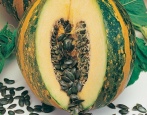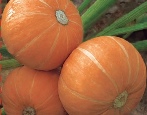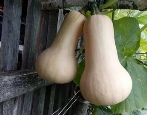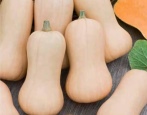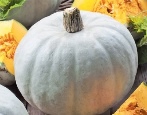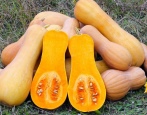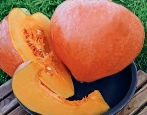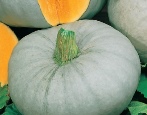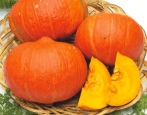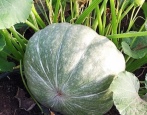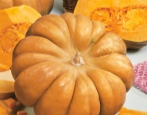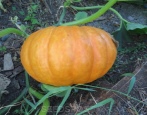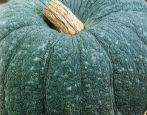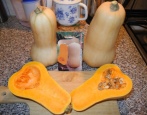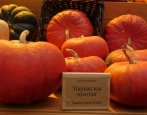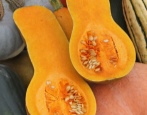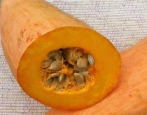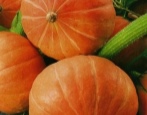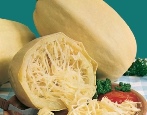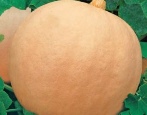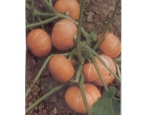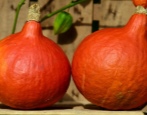
- Authors: Tsibulevsky N.I., Shevchenko L.A., Kulish E.M.
- Year of approval: 1998
- Lash length, m: 3-4
- Leaf shape: pentagonal
- Leaf color: dark green, with white spot
- The form: cylindrical with a slight thickening at the flower end (elongated pear-shaped interception)
- Weight, kg: 2,3-4,6
- Coloration: background orange-brown, pattern in the form of a grid and spots of orange-brown color
- Bark: thin, leathery, creamy on the cut
- Color of the pulp: red-orange
Pumpkin is rich in minerals, vitamins and antioxidants, and it is also free from fat and cholesterol. That is why it is so often chosen for diet food and for allergy sufferers. Prikubanskaya pumpkin is a fairly old and well-known variety that has not lost its relevance to this day. The species has its own number of advantages, for which it is chosen.
Breeding history
Prikubanskaya belongs to the Muscat species. Mexico is considered the homeland of these pumpkins, so many of these varieties do not take root in Russia. But Prikubanskaya, bred in 1998, was approved for cultivation in many regions. The breeders were Tsibulevsky N.I., Shevchenko L.A. and Kulish E.M.
Description of the variety
The main advantages of the Prikubanskaya pumpkin are considered to be the useful qualities that are contained in the pulp. The skin is easily and neatly separated from the fruit. The inside is soft and very juicy.
Summer residents really like the fact that the pumpkin is unpretentious both in care and in the choice of soil.
Due to its good and elastic peel, as well as keeping quality, the variety can be transported over long distances without losing its appearance and quality.
Among the disadvantages, it is noted that the culture has a weak immunity to temperature extremes or even slight frosts. Therefore, in the spring, at the time of possible frosts, everything is covered with agrofibre or other protective containers.
Characteristics of the appearance of plants and fruits
The bush is medium-growing, the length of the main shoots is 3-4 m, and the lateral ones are 2-3 m. The leaves are small, medium-sized. Their shape is pentagonal, with a dark green color and a slight white spot.
The fruits are oblong cylindrical in shape, they have a slight thickening at the bottom. The weight of the vegetable is 2.3-4.6 kg. The skin is orange-brown in color, with a mesh of orange-brown spots on the background. The skin is smooth, thin. The segmentation is weak.
The pulp is tender, firm, juicy and soft. The thickness in the section in the widened part is 3-4 cm. It is red-orange in color.
The nest is small. There are 5 planets inside. They are located flat, closed and very tight. The seeds are medium-sized, oval-elongated. They are light gray in color with cream ribs. Their number is equal to 0.8%.
Fruit keeping quality is good, on average 90 days.
Purpose and taste
The culture is universal. It can be used to prepare various dishes (from puree to vegetable stew), as well as in cooking.
The pumpkin taste is rich and bright. The dry matter in the pulp is 11.5%, the amount of sugar is 6.3%. There are 12.2 mg of carotene per 100 g of raw material. Caloric content per 100 g is 45 kcal.
Ripening terms
The variety is mid-season. The entire ripening period takes 91-136 days. Harvesting occurs in July-September.
Yield
Pumpkin has good yield indicators: 104-189 centners per hectare are removed on average.
Growing and caring
The seedling method is suitable for most regions with cool climates and unstable rainfall in the spring. Therefore, seed preparation should include the following.
Processing and germination of seeds. Soak the material in hot water (40 ° C) for about 3-4 hours.Then they should be removed and wrapped in damp gauze or cloth. Place in a container, cover with a loose lid and wait for the seeds to germinate. It usually takes 3-5 days. From time to time, the fabric should be spilled with water.
At this time, peat pots are harvested, since the pumpkin does not like transplants. It is necessary to fill in a little cultivated land.
The soil should be shed before sowing. 2 seeds are planted in one container.
After germination, the strongest is selected from 2 sprouts.
Transplanting into open ground is carried out in the presence of 2-4 strong leaves. The procedure is carried out at the end of May, when the soil warms up to + 16 ... 18 ° С.
The bed must be dug in advance, and peat, sand, humus and mineral fertilizers should be added to it.
In the spring, everything is dug up again, while holes are formed with a depth of 10 cm, according to the scheme 60x60 cm.
The subsequent care of the culture should not be difficult.
Watering should only be done with settled warm water, the temperature of which should not be lower than + 20 ° C. One plant should have from 5 to 7 liters. During the growing season, the amount can increase to 10 liters. Moisture is applied strictly at the root. The procedure is carried out before the ovaries 1 time in 7 days, after - 1 time in 14 days. After watering, the soil is loosened and weeds are removed.
You can feed it with nitrophos, a solution of mullein and wood ash.
It is necessary to form a bush regularly; thickening of shoots and peduncles should not be allowed. As soon as the culture has formed from 2 to 4 fruits, the remaining buds are pinched.
Pumpkin bushes are inspected weekly for disease or pests. For prevention, you can spray everything with soapy water or tobacco ash.
